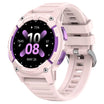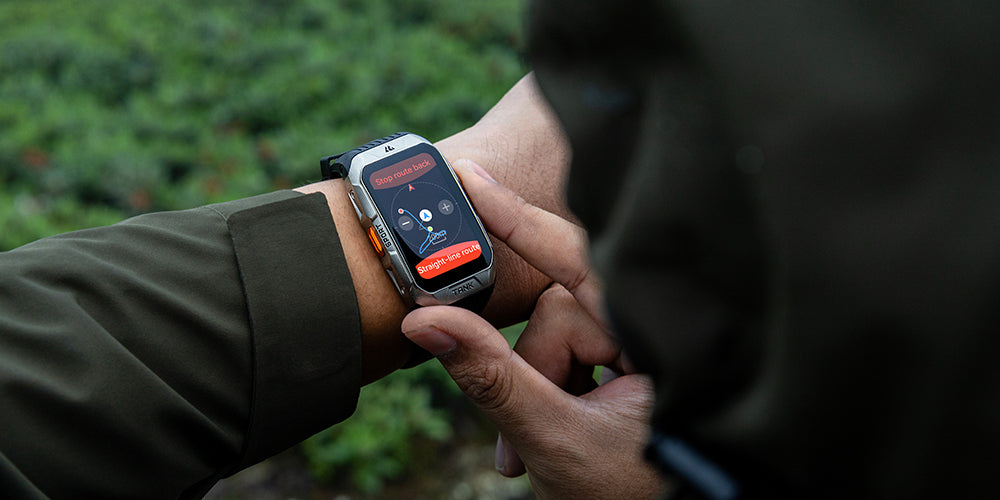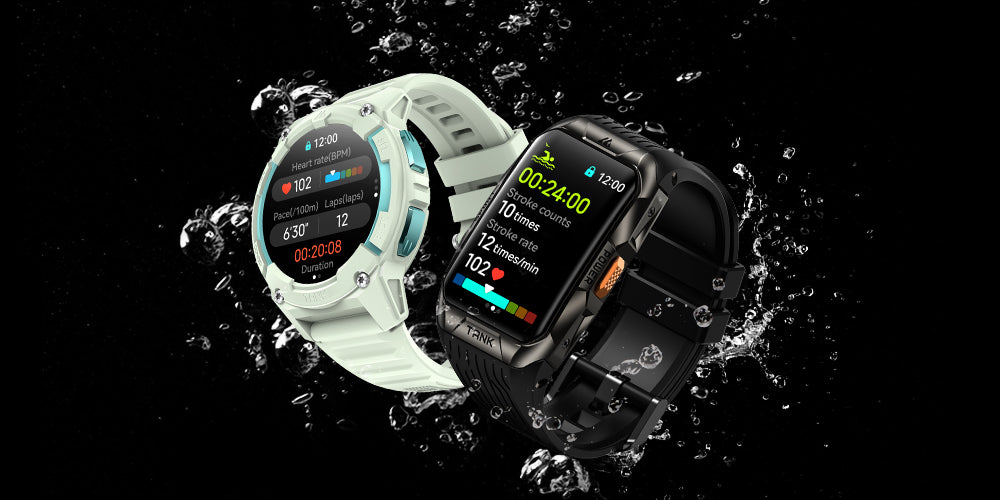The highly anticipated KOSPET TANK X2U & S2 smartwatches were recently released, featuring upgraded GPS with support for workout route records and route back features. As an outdoor enthusiast or adventurer, you won't want to miss this detailed guide on GPS smartwatches.
In this guide, we'll cover the key benefits of GPS smartwatches, important factors to consider when buying one, a feature comparison of KOSPET's latest models, and additional tips to make the most of your GPS smartwatch experience.
What Are the Benefits of GPS in Smartwatch?
The inclusion of GPS in smartwatches has significantly enhanced their utility, especially for those passionate about fitness, outdoor activities, and personal safety. Here are some of the key benefits of having a smartwatch with GPS:

Real-time tracking and navigation
When you're outdoors, whether for sports or adventure, it's hard to say you'll never venture into remote areas–places often devoid of landmarks or clear signs. In such circumstances, having a smartwatch with GPS becomes essential. It provides precise navigation and route tracking, ensuring you're always on track. You can load your route before starting your run, or follow a path shared by others without the anxiety of getting lost.
Workout route planning and records
Smartwatches with GPS allow you to plan and follow specific running, cycling, or hiking routes. They also track the routes you take, which is incredibly useful for monitoring progress or reviewing your workout performance. This feature is particularly valuable for outdoor enthusiasts and athletes, especially those who enjoy exploring new paths.
Accurate distance, pace, and elevation measurement
You might not realize it, but many outdoor sports rely heavily on GPS. One of the key advantages of a GPS smartwatch is its ability to accurately track your running distance, pace, and elevation changes–especially in trail running, where these metrics can differ significantly from outdoor running due to the complex and varied terrain. With a GPS smartwatch, you can access real-time data, such as your elevation gain and loss.
Safety features
GPS smartwatches for running typically come with safety features such as abnormal heart rate alerts and blood oxygen monitoring. These features provide an added layer of security when running in remote areas or harsh environments, allowing you to enjoy your workout with peace of mind.
Fitness tracking
In addition to navigation and tracking, GPS smartwatches for running can health metrics such as heart rate, VO2 max, and calorie burn. For beginners, understanding these data can help them adjust their training plan, improve endurance, manage workout intensity, and prevent overtraining. Many GPS smartwatches also offer sleep tracking.
Important Factors to Consider Before Buying a GPS Smartwatch
When purchasing a GPS smartwatch, there are several factors to consider, including GPS accuracy, durability, fitness and health features, connectivity and compatibility, as well as the brand and price. If you're planning to buy a GPS smartwatch, keep reading!
GPS Accuracy
Determining whether GPS is accurate requires consideration of a number of factors, including the equipment used, processing techniques, whether phase data are used, whether differential GPS techniques are applied, and whether static or dynamic measurements are made. By considering these methods and factors, the accuracy of a GPS system can be evaluated. (See https://www.oc.nps.edu/oc2902w/gps/gpsacc.html)
For example, single-frequency GPS receivers are susceptible to signal reflections, especially when the signal reflects back from large buildings or natural terrain (e.g., mountains, trees, etc.), known as multipath errors. This error can lead to inaccurate positioning, especially in dense urban buildings or natural environments where signal reflections are more severe. Dual-frequency (or say dual-band) GPS systems are better able to recognize and suppress these reflections. By simultaneously receiving satellite signals in two frequency bands (usually L1 and L5), dual-frequency systems can more effectively deal with multipath effects and improve positioning accuracy in complex environments.
KOSPET's newest models such as the X2U and S2 are equipped with dual-band & 6 satellite positioning systems (GPS, GLONASS, BeiDou, Galileo, QZSS, NAVIC), which significantly improves positioning accuracy over older models, as well as workout route records and route back features.
Toughness and Build Quality
The case material, durability, and water and dust resistance of a smartwatch determine its ability to operate in a wide range of extreme environments. Many smartwatches such as KOSPET's products are made of stainless steel, titanium alloy, zinc alloy, etc. In addition to excellent GPS, they are also waterproof, allowing them to be used in swimming, diving, and even heavy rain.
Fitness and Health Features
Most smartwatches come with common fitness and health features, but smartwatches with GPS often offer more advanced features. When purchasing a GPS smartwatch, make sure to choose one that includes heart rate monitoring, step counting, blood oxygen monitoring, and route tracking. These features will help you comprehensively track and improve your physical health, especially during outdoor high-intensity workouts.
Connectivity and Compatibility
Most smartwatches can connect with devices such as smartphones or laptops, making it easy to sync data, receive notifications, and perform updates. Many brands now offer GPS smartwatches that are compatible with both Android and iOS systems. Additionally, some smartwatches can sync with other fitness devices, music players, or workout apps.
Brand and Price
Firstly, the brand determines the technical stability and accuracy of the smartwatch. Well-known brands usually invest more resources in R&D to provide more reliable positioning functions, such as multi-satellite system support or accurate route recording, which is crucial for outdoor sports enthusiasts and users who need to navigate.
Secondly, the price directly affects the technical configuration and performance of the smartwatch. Higher-priced GPS smartwatches are usually equipped with advanced positioning technology, longer battery life, and more additional features such as offline maps or built-in barometric altimeters. Moderately priced products, on the other hand, maybe more focused on meeting basic positioning needs and are suitable for daily use or beginners.
Therefore, when purchasing a GPS smartwatch, consumers need to combine their usage scenarios, budgets, and the brand's technical strength to choose a product that offers both cost-effectiveness and performance.
KOSPET's Latest GPS Smartwatches: Feature Comparison of TANK X2U, S2, and M3U
| Model | Price | Key Features |
GPS
|
Battery Life |
| X2U |
$149.99
|
|
Workout Route Records & Route Back Support |
|
| S2 | $149.99 |
|
Workout Route Records & Route Back Support |
|
| M3U | $149.99 |
|
YES |
|
More Tips and Facts You Might Want to Know About GPS Smartwatches
Learn more tips and frequently asked questions about GPS smartwatches to help you make the most of these devices. Here are some common questions and answers about it:
You might find that this video can solve most of your problems while using a GPS smartwatch:
How does a GPS smartwatch work?
A GPS smartwatch is equipped with a GPS receiver that communicates with satellites to determine its precise location. When GPS is enabled, the smartwatch begins searching for satellites in the sky. To accurately calculate its position, the smartwatch needs to connect to at least four satellites. Once the connection is established, the positioning begins. The smartwatch receives signals from multiple satellites and uses triangulation to calculate its location. By measuring the distance between the device and each satellite, the exact location is determined.
Can I use my GPS smartwatch without a smartphone?
Many features, such as notifications, GPS, and apps, require a connection to your smartphone. However, some smartwatches come with built-in GPS, allowing you to track your location and record routes during activities like running, cycling, and hiking. This feature is especially useful for outdoor enthusiasts, as it enables them to map and record their workouts without the need to carry a phone.
How long does the battery last when using GPS on a smartwatch?
The battery life of a smartwatch with GPS enabled varies depending on the model and brand. For example, the latest KOSPET TANK X2U can last up to 10 hours with continuous GPS use, while the TANK S2 lasts 15 hours, and the TANK M3U offers an even longer battery life of up to 35 hours.
Can a GPS smartwatch track elevation and altitude?
Most GPS smartwatches are capable of tracking elevation and altitude, primarily using two methods:
- Cross-referencing GPS coordinates with a known elevation database to obtain accurate altitude data.
- Using a smartwatch equipped with a barometric altimeter sensor, which measures elevation based on atmospheric pressure data.
What should I do if my GPS smartwatch loses signal?
- Walk outdoors and restart the watch. If you are experiencing GPS disconnection inside a building, it is recommended that you walk outdoors to an open area, such as a balcony, and turn off the watch. Once outdoors, try turning the GPS back on. If the GPS does not connect, restart your watch.
- Update your smartwatch's operating system and apps. Make sure your smartwatch has the latest system software. If not, update it immediately.
- Replace the metal band. The metal band may interfere with the positioning sensor and block the signal transmission.
- Reset your watch. If none of the previously mentioned methods work, try resetting your smartwatch. If the problem persists, it is recommended to seek professional smartwatch repair services.















Leave a comment
All comments are moderated before being published.
This site is protected by hCaptcha and the hCaptcha Privacy Policy and Terms of Service apply.